Cooper Kupp’s Approach to Greatness
Last spring, before Cooper Kupp turned this season into an argument for NFL history, he moved to a Portland suburb and transformed a backyard tennis court into a barn that doubled as a football laboratory. The goal: Explore the science that drives elite receivers. Dive to subterranean depths. Examine his job, and how to excel even more at it, through analytical concepts of movement. Like dynamic organisms. And uncontrolled manifolds.
In Kupp’s latest football experiment, the dynamic organism was … him. Hence the barn, the space covered and enclosed, the design created by a Rams wideout moonlighting as an interior designer. Kupp had turf put in by the same expert local sports teams used. He added a “curve” treadmill for speedwork; a “timing gate” that measured in seconds and miles per hour, with 20 mph serving as his benchmark; and what’s called a “towing unit,” which he wore while sprinting to add resistance (typically 50% to 75% of his 208 pounds). He didn’t overly complicate this lab with technology, only what he needed, everything deliberate and precise. Like him.
Plan in place and barn constructed, Kupp drilled into as many movement options (wiggles, cuts, stutter steps) as he could develop or hone. The uncontrolled manifolds approach is not just a collection of those movement options, but how his body chooses them—ideally, through subconscious calculations performed by his central nervous system. All must be deeply ingrained so that he can access and deploy them instantly, at any moment. He would take variables—alignments; schemes; skills, weaknesses and body language of defenders; weather; playing surface; and equipment, like which cleats he wore—and input the data he gleaned into an internal calculator.
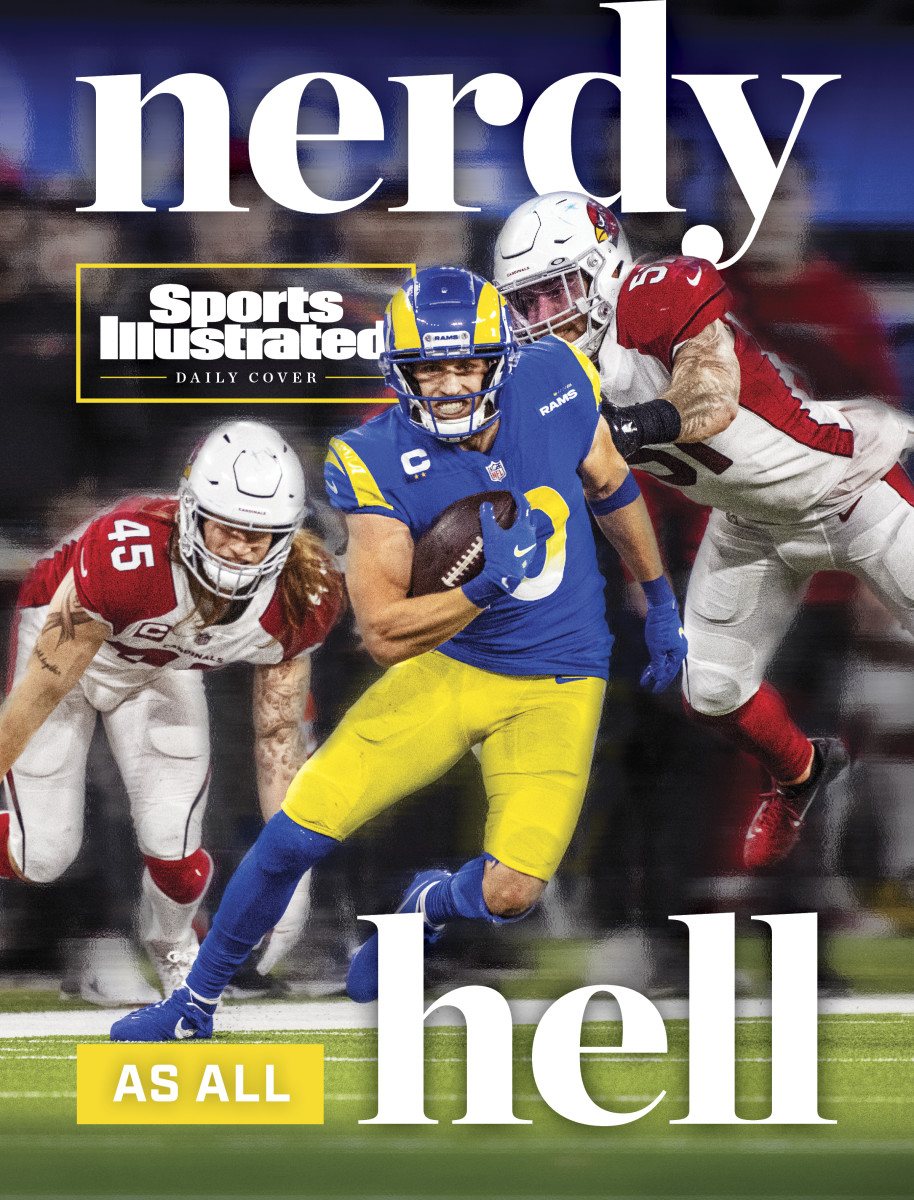
Kupp would go on to lead the NFL in receptions (145), receiving yards (1,947) and touchdown catches (16). But while the numbers he amassed were borderline historic, what he did mattered far less to him than how he did it. En route to exactly the right place, at precisely the right time, his central nervous system acted like a computer processor, shuffling through his repertoire of movement options. More choices and higher efficiency made Kupp more shifty and more adaptable. When his mental processing sped up, the game slowed down, as he beat not just defenders but entire defensive schemes—and not just with speed, strength or smarts. He upended them through manipulation, with movement, his choices dictating their response.
Start there to understand how Kupp became only the fourth wideout since 1970 to seize the “triple crown” and how he built a plausible argument—one that he himself would never make—for the best season at his position in NFL history. Just don’t define his magical year by the numbers most would slap onto social media alongside a #humbled or a #blessed.
Although he had toiled, Kupp doesn’t view this season as 17 happy accidents born from a tireless work ethic. Although genetically gifted, he didn’t overwhelm double teams with physical prowess alone. Although brainy, he refused simple categorization, in particular the notion that he’s “crafty,” a backhanded compliment laced with the implication that he needs to be. There’s truth in every overdone element of his story. Teammates describe him as borderline brilliant. He was discounted; he did run a glacial 40-yard dash at the NFL scouting combine, his time of 4.62 seconds matching that of a speedy punter, Pat O’Donnell of the Bears. But those factors don’t paint Kupp in total.
Instead, his approach—clinical, surgical, endless, compounding, efficient and nerdy as all hell—guided Kupp’s ongoing football evolution. As he transformed from undersized, overlooked prospect to FCS star to mainstay for a perpetual playoff team, it’s how he defined himself, while others consistently mischaracterized him. He needed his science and his natural athletic gifts to morph from a great player into something more.
That’s why Kupp visited Ryan Baugus—founder of Headquarters Wellness—in Wilsonville, Ore., last spring. Why they diagrammed movement options inside a gym, plotting a path toward, Baugus says, “doing something special.” Which explains not only Kupp’s season, but everything he channeled into it.
The journey to Kupp’s slice of NFL history began with a single step, although not an obvious, or metaphorical, one. No, Kupp winnowed his focus to one actual step, his first off the line of scrimmage—football’s most critical movement option.
Kupp also arrived at that specific emphasis last spring, with an assist from Erik Jernstrom, the director of sports performance at EForce Sports in the Portland area. They created an “athletic profile” through a battery of test results and GPS info from the Rams. The data revealed that Kupp reached max velocity sooner than most elite receivers—closer to 25 yards down field, or roughly five yards faster than the norm. They compared how many yards he covered in any one game with how many of those yards he traversed at various percentages (70%, 80%, 90%) of his max velocity. For Kupp to reach top speed sooner and cover greater distance at all percentages, that one small step for one (not-small-anymore) man figured to yield enormous gains.
Then they tailored his training program to address that specific movement, and not for every day or every session, but for every rep. Jernstrom viewed Kupp as a “phenomenal accelerator,” quick, fluid and “aggressive in his bursts.” To upgrade “phenomenal,” they turned to drills, sprints and an ancient Chinese military treatise, The Art of War. The book highlights one relevant combat strategy, the concept of space—creating your own or decreasing your enemy’s—whether applied to the Battle of Normandy or an NFL play. Kupp could create separation, or decrease the cushion cornerbacks desired, if he knew where to go, how to get there and how to deceive them. Which led to the OODA loop, a four-step approach, developed by U.S. fighter pilots—observe, orient, decide and act—to make decisions under extreme pressure with clarity and decisiveness.
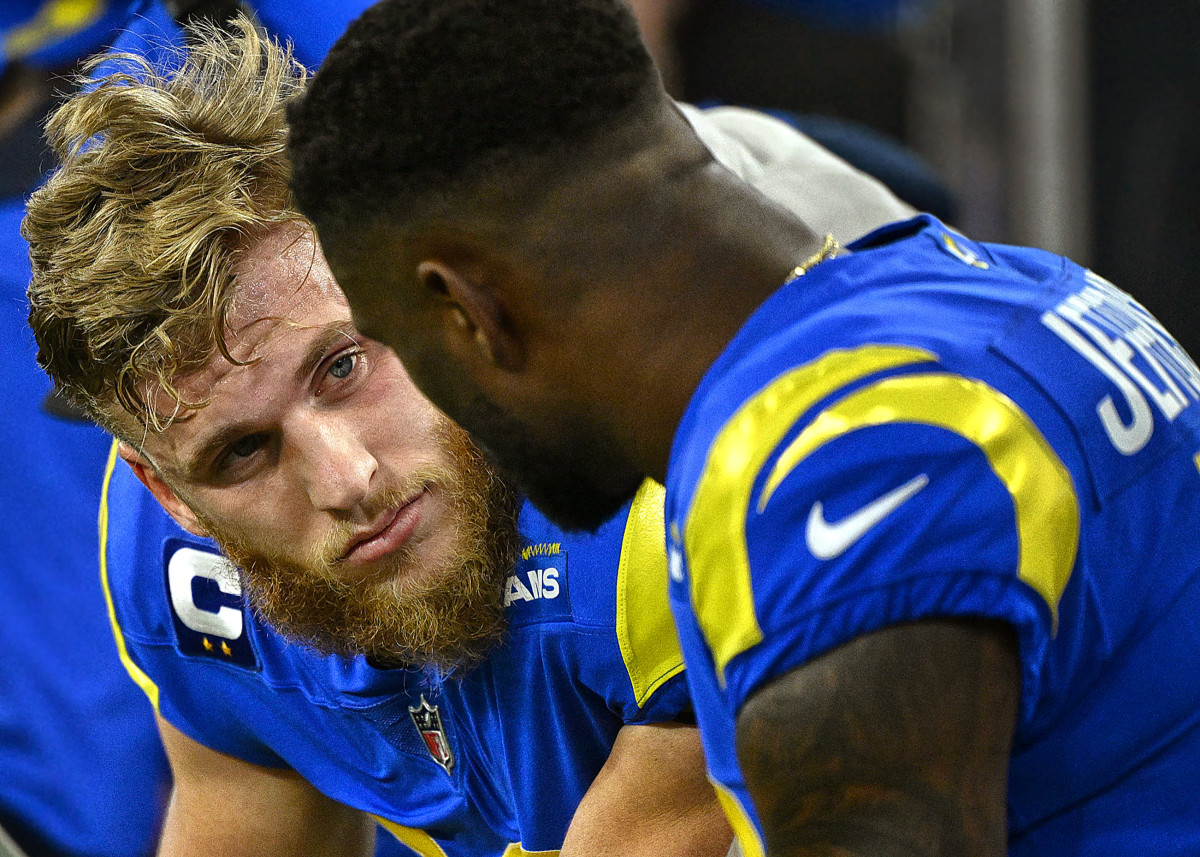
Long before Kupp elevated into the rare air breathed by some of the most accomplished receivers in NFL history—marquee names like Jerry Rice, Michael Irvin and Calvin Johnson—he designed his experiments to ensure he would be nothing like them and exactly so. Kupp would never match Rice’s pedigree (“greatest of all time,” he says), Irvin’s competitive nature (“incredible”) or Johnson’s superhero athleticism (“dude is a cyborg, jumping over three people without planting his feet”). But if Kupp dreamed beyond logical expectations, conducted the right tests, worked assiduously to improve and timed everything perfectly, what seemed impossible to most appeared quite possible to him.
After playing the word-association game for three Hall of Famers, Kupp does the same for himself. “I just want to do my job,” he says.
That his job is the same as their jobs never altered Kupp’s ambitions. He simply needed to take a different, well, route to the same place. How else would he approach the game-changing authority of someone like Johnson, who is three inches taller, almost 30 pounds heavier and—no offense to the Kupp family—genetically more gifted in every way?
Rice sprinted up towering hills and caught bricks to harden his hands. Irvin lifted weights in full uniform, helmet atop his head in 100-degree heat and a heavy vest secured around his torso. Johnson partook in Navy SEAL–like drill sessions. To match them, Kupp decided: He would become a dreamer, a transformer and a football scientist, defined not by one part of his approach but by the totality of it. At that point, he needed to answer one question above all: How?
Kupp doesn’t view his improbable season as improbable at all. Instead, he sees more than a dozen factors that coalesced into something greater, just as he intended. Some elements, like work ethic and film study, were standard; others, like first steps and uncontrolled manifolds, scientific; others, like his complete and wide-ranging skill set, developed over seasons, or decades.
The first factor that pointed Kupp toward NFL lore is perhaps the most central of all—and the most unexpected for a football scientist. He grew up in Yakima, a city of 93,000 people roughly 140 miles southeast of Seattle. While best known for apple orchards and wineries—and sometimes jokingly referred to as the Palm Springs of Washington—Yakima can also present a limited view of future possibility, with pockets of gang violence, gunshots that interrupted football practices, a median household income of $44,950 and a poverty rate that has climbed over 20% in recent years. Add in Yakima’s remote location relative to major cities, and it’s rare for anyone to see a future as bountiful as Kupp did.
He can thank his paternal grandfather for that.
Jake Kupp grew up on a farm. With money tight, his mother insisted that he read, because she wanted Jake to visualize far-away worlds and transport to them, hoping to broaden his outlook beyond, Jake says, “what my ‘normal’ capacity would be.”
On hot summer days, when the harvesting concluded, he settled under a peach tree. Lying down and looking up, he visualized an impossible future: playing baseball for the Yankees. He would manifest those visions, transform his body and transcend the limits of his circumstances. He did become a professional athlete, although in football, where he played 12 seasons for four franchises, earning a Pro Bowl nod while with New Orleans.
Jake returned to Yakima and passed the dream gene to his son, Craig, who carved out his own NFL career, as a backup quarterback with three NFL teams and for two World League franchises. Both created an incubator for young Cooper, while he crashed into the now-dented fence in the backyard of his family home or sidestepped the sandbox into an end zone marked off by a garden hose stretched across the grass. Jake read him The Little Engine That Could. Craig told Cooper he could do anything he wanted.
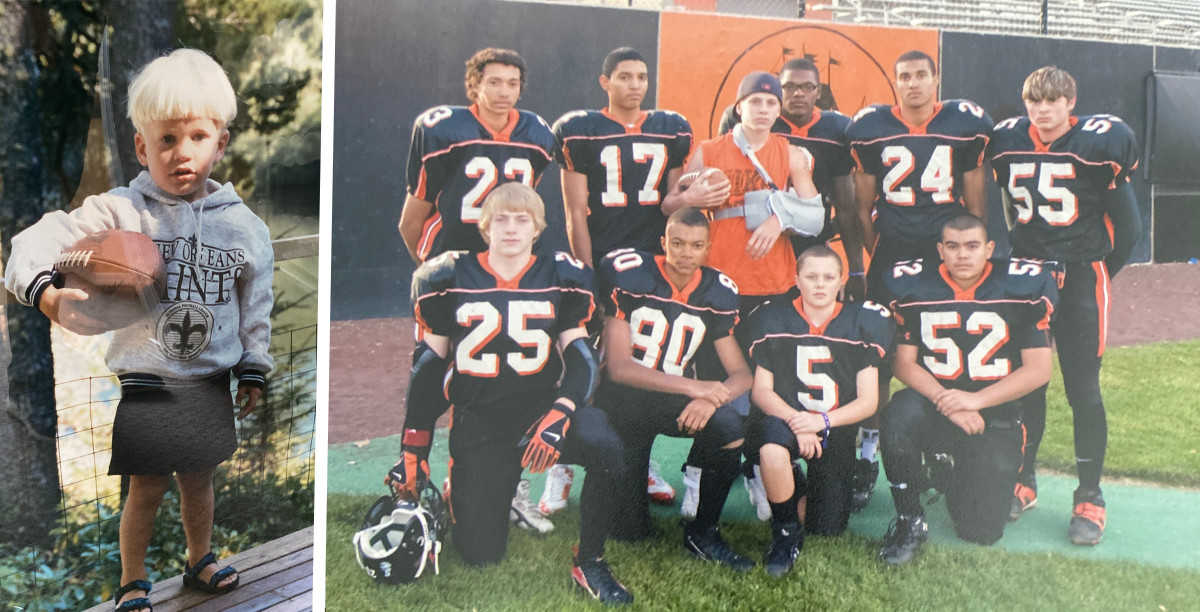
For a future football scientist obsessed with objective data, Cooper could have looked at his size (way under 150 pounds entering high school) and his prospects (no Division I scholarship offers) and the small number of white NFL receivers and come to an obvious conclusion: He held, at best, infinitesimal odds. Instead, his family taught him to see beyond.
Cooper’s aspirations grew in lockstep with his body. He watched film of legends: Rice, Irvin, Johnson, Marvin Harrison, Randy Moss. But rather than see what he could never be, he dreamed of something else: his future.
One morning before his sophomore football season, Cooper cornered his coach, Jay Dumas, in the weight room that doubled as his peach tree. Did Dumas think he could play in college? Yes. Maybe. Could. “In the back of my mind, I thought he’d probably play at Central Washington,” Dumas says, referring to the nearby Division II program.
Cooper asked: What about the NFL? Dumas stifled his laughter, laid out percentages that screamed no and kept his true thoughts—that’s not realistic—to himself. But Cooper wasn’t done. He confessed to another goal, his loftiest. He wanted to enter the … Pro Football Hall of Fame. Dumas waited for the punch line that never came. Even if Cooper achieved his “normal” capacity, his “do anything” landed in outer space. Let him dream, Dumas decided.
Karin Kupp ran marathons, taught fitness boot camps and competed in extreme endurance races. There’s a picture of her in the family basement hurtling through actual flames. Cooper sometimes tagged along and, in his teens, he completed a mini-triathlon alongside her. His parents snapped a picture: Cooper lying on the ground afterward, exhausted, unable to move. They alternately loved and worried about his determination. They wanted Cooper to harness what drove him, to find a proper equilibrium, a notion made prominent by the ulcer he developed in sixth grade. With little else to explain the diagnosis, they wondered whether Cooper cared too much, whether what fueled his plan had flooded his digestive tract with acid.
Cooper never stopped pushing, and not in the cliché sense, like a bad answer to the what’s-your-greatest-weakness job interview question. His pushing-pushing-pushing could add risk he might have otherwise avoided. Cooper played basketball to develop agility and yet inevitably ended up near the basket, elbows flying, taking on opponents who doubled his size. Yes, he tipped in a shot that kept alive the season when Davis High won the state championship. But that same fearlessness led to a broken collarbone on the football field, stoking concerns over a dogged approach that was admirable and questionable. Admirable because nobody worked harder, looked deeper, tried more approaches. Questionable because no matter how hard he pushed, his odds would remain low, his dream just that. Cooper had to weigh a risk-reward calculus, had to answer: At what cost?
Did he really need to wear ankle weights all day long? Did he absolutely have to befriend the school’s custodian so he could access the weight room at all hours, dumbbells clanking each morning before sunrise?
Cooper uncovered unexpected answers, finding balance in the hours devoted to a singular pursuit. Every element of his approach made him better at the others. He needed to gain size and strength, so that half of the numbers on his jerseys wouldn’t disappear when tucked in. He needed to dribble for hours on end to improve his coordination for football, needed to round out his gridiron skills with stints at running back and on defense, needed to skateboard and break-dance to develop body control. The sum of his efforts would be the foundation of what elevated him. He simply needed to fortify both his body and his mind.

The sports world met Cooper Kupp, football scientist, in December, when he gave one of the most detailed answers in the history of on field, postgame interviews. To casual fans, his response to an NFL Network reporter after a victory over the Jaguars might as well have been delivered in French. It was all “a little three-deep fire zone,” “nickel off the edge” and “I knew we were gonna get three pushing through”—three data clues that, when inputted, revealed he needed only to beat one defender for an easy score. His answer—delivered like a stream of consciousness, clinical and monotone—transformed a performative exercise into a brief X’s-and-O’s seminar. Teammates laughed as they passed the clip around, joking about Kupp and how his brain works. So much for the cliché answer, Goff texted Kupp that night. The clip went viral, leading to delightful social media commentary like, “when I ask the technician what’s wrong with my car.”
Baugus saw something else: a window into how Kupp thinks. “I got the impression that it was maybe a joke to him,” Baugus says. “He had this little smirk on his face. It was real subtle, like, I’m going to give you a little taste of what goes on in my head.”
Kupp sharpened his mind in places that rarely shape All-Pro careers. Like math and science classes. He earned A’s, but the concepts relevant to football (physics, physiology, body mechanics) mattered more, because he could apply them.
In college at Eastern Washington, Kupp majored in behavioral economics. He turned his frustration with the recruitment process—and its inherent subjectivity—into a senior project, developing his own model to evaluate prospects. Kupp declined to share in depth what he created, beyond the basics: He crafted a model, with code he wrote himself. “He found [it] to be fairly predictive,” Craig says.
Kupp wanted answers. He loved data points and objectivity, and making sense of numbers came easily to him. At Davis, he scoured more game film than most coaches. In college, he would stop by the office of Jeff Schmedding, Eastern’s defensive coordinator, and ask a million questions designed to net a more holistic view of the game. In the NFL, he eats breakfast with his quarterbacks—first, Goff; now, Matthew Stafford—centering discussions on offensive schemes.
On some level, all receivers take similar approaches. But Kupp elevated hard work with his experiments, his process more thorough and encompassing. He also struck teammates as genuine in his bearing—fittingly, a word defined as a machine element that constrains relative motion to only the desired motion. He lacked bias, like when discussing his own highlights tape. “I’m not sure I’d recruit that guy,” he’d say.
That’s Kupp, a player who loves preparation, the nuances and intricacies that combine for a symphony of movement options on every snap. Former coaches saw in him neurotic tendencies. They debated whether he had a photographic memory or whether he processed information so quickly that it just seemed that way. Goff describes Kupp’s speed and accuracy at distilling relevant facts as a “savant-type ability to understand defenses that’s greater than anyone else in the league right now.” Dumas says Kupp’s career stems from “the advancement of his psyche.”
The football scientist understood that, for his grand experiment to work, one notion came to matter above all others: timing.
The silence from his preferred college destinations, USC and Stanford, led him to Eastern Washington, where Dumas had once worked as an assistant for his high school teammate, the Eagles head coach, Beau Baldwin. Timing.
Eastern played on a gaudy field with red turf. They showcased a soaring offense, led by three FCS All-American wideouts who turned games into dizzying blurs. Kupp redshirted, allowing for more development. Timing. “If he had gone to Stanford,” Dumas says, “he’d probably be in Congress right now, changing laws.”
Even in the FCS, Eastern clashed with Pac-12 teams each season. Kupp elevated his NFL prospects against NFL-caliber defenders, whether dominating Oregon State in 2013 (five receptions, 119 yards and two touchdowns in his college debut), Washington in ’14 (8-145-3), Oregon in ’15 (15-246-3) or Washington State in ’16 (12-206-3).
Still, this wasn’t the SEC. This was the smallish kid from the smallish city who carried a tennis ball everywhere, throwing and catching it to improve his coordination, who tore up mostly subpar athletes, doing unusual things on an unusually red field. Despite his production, NFL franchises showed only modest interest, until perfect timing aligned again.
Had his grandfather not played for the Saints, Jake would not have blocked for Archie Manning. Had they not become friends, Jake would not have been able to, decades later, call in a favor. Had he not phoned Archie, his grandson would never have snagged a coveted invite to the Manning Passing Academy, nor spent several summers there, as a counselor, where he became a favorite of Archie’s famous, Super Bowl–winning sons. They would not have fallen in love with his precision, the science experiments beginning to manifest in drills. Nor would they have argued one fateful day over who would throw to him.
When Peyton was readying for his final season, he would not have gone full older brother one summer. He would not have insisted Cooper run routes only for him. Eli wouldn’t have protested. And Les Snead, the Rams’ general manager, wouldn’t have been standing a few feet from the debate, close enough to overhear them. He saw a resoluteness in Peyton’s eyes that prompted him to write down a single sentence in a notepad.
Who the heck is Cooper Kupp?
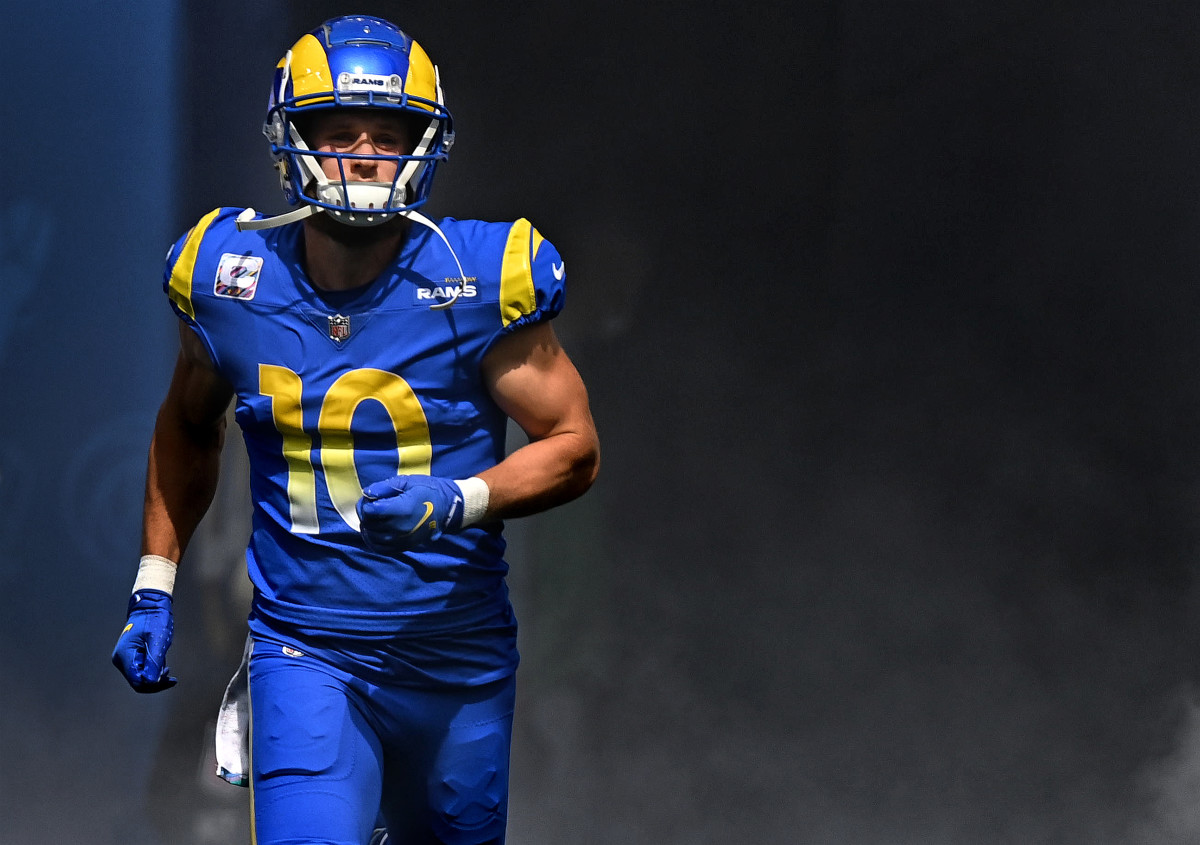
In attempting to answer his own question, Snead began uncovering all the elements that pushed Kupp beyond his “normal” capacity. Kupp didn’t use positive affirmations. Instead, he told himself, “You’re not good,” and “You’re lucky,” and “You don’t deserve this.” This didn’t stem from a lack of confidence, but rather from his all-inclusive approach, where every detail mattered, even for negative self-talk meant to ward off complacency. Snead discovered that Kupp loved football, that one coach compared him to a golden retriever because he enjoyed even the most mundane tasks.
Snead reminded his team of evaluators that, for all the available analytics, data only informed their choices. He kept returning to a favorite saying. “All things considered, where are we …” Meaning: What does their gut say? His gut told Snead that Kupp could make Pro Bowls, lead teams, win championships.
“It was like going to an orchestra watching him,” Snead says. “Beautiful music, all the right angles.” Did it matter whether another wideout jumped an inch higher? Or wore the jersey of, say, Ohio State? Maybe. But all things considered … “There was just something about his central nervous system,” Snead says, “that figured out the geometry of football.”
Ideal geometry bolstered another notion: Kupp could flat-out play. Because of his experiments, his brain, his transformed body and all the other factors he drew on while ascending, he was much closer to his dream than anybody, besides Kupp, seemed to realize.
The rest of the NFL would find out soon enough, as the football scientist began to carve out the very career he designed in those experiments. He started to break free from the overly simplistic narrative that enveloped him. For Dumas, descriptions of Kupp as the crafty underdog were grounded, at least partially, in race. “There’s a weird undertone,” he says. “Yeah, he’s a white receiver. But when we put so much emphasis on how smart he is, we miss his athletic gifts. He’s not Steve Largent. He’s not deceptively fast; he’s fast.”
Kupp’s new Rams teammates somehow found out about his Hall of Fame objective, and several joined the laugh track that started in high school. Looking back, Kupp understands the skepticism. He can hardly watch film from his rookie season; it’s like he’s running in slow motion. He hates how he wore his uniform—remember, details matter—and he could never quite figure out the right type of socks.
He went back to the lab, starting with “a literal and figurative look in the mirror,” each new trial designed to yield another step in his football evolution. In 2018, he focused on increasing his speed and explosiveness, combining test results (velocity, acceleration, force) with movement tweaks and sprint workouts he conducted with teammate Robert Woods. In ’19, he shifted to rehabilitation to strengthen his left knee, after tearing an ACL the previous season. He sought out knee specialists, rehab experts and even competitors—like Chargers wideout Keenan Allen—for data he could apply.
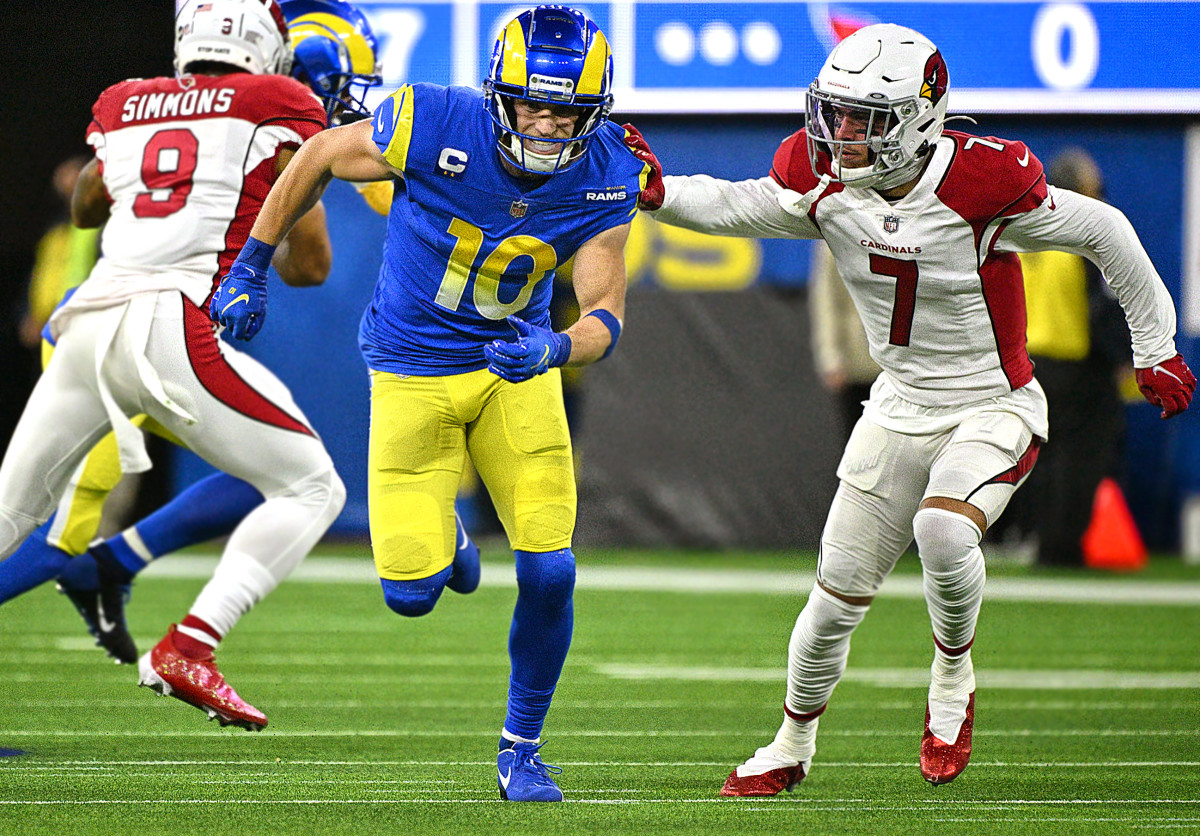
While rebuilding his body, Kupp shifted the extra time he would have spent at practice toward an immersive study aimed to make him a better blocker, an act many receivers disdain. Kupp embraced the hand-to-hand combat, because it meant more snaps and, potentially, more confusion for defenses that could guess “pass attempt upcoming” when he trotted onto the field. He added muscle without losing speed, measuring his movement after every ounce he gained, until he weighed 208 pounds. He peppered left tackle Andrew Whitworth—now the NFL’s second-oldest player—for advice on angles, leverage and the geometry necessary to apply brute force.
In 2020, Kupp fixated on mastery, elevating his more complete skill set through minor tweaks implemented from his investigations of improvement. The Rams didn’t carry a fullback on their roster that season, because they now had one who also caught 92 passes and gained 974 receiving yards. Kupp did play more, and in more places, rotating through receiver positions, in the slot one play, outside the next. This season, Kupp became the first player since 2016 to catch at least one pass from all seven pre-snap alignments a receiver can start out in.
The smaller, deliberate experiments started to combine, and the combination transformed gradual progress into exponential enhancements. No Rams laughed at Kupp anymore, except when referring to him by the nickname—the third Paul brother, due to his resemblance to the YouTubers turned boxers. Despite sharing a roster with and yielding the spotlight to franchise cornerstones like Aaron Donald, Jalen Ramsey, Stafford and Whitworth, Kupp and his fellow receivers came to, in the eyes of several colleagues, form the soul of the NFC West champs.
Kupp continued to test and retest last spring, combining his focus on manipulation by analyzing Allen’s film, because he saw the Chargers Pro Bowler as one of football’s great escape artists, able to separate all over the field. Kupp also dug into Chris Godwin’s tape, attempting to ascertain how the Tampa Bay receiver contorted his body in the middle of the field, both to catch passes and avoid hits.
By June, Kupp’s trainers could sense his “positive expectancy” for 2021, the result of his lab-based gains and the addition of Stafford. When Kupp sent his father videos of his acceleration, his quicker first step leapt off the screen. Everyone else started to see what Kupp long-ago envisioned. “This is gonna be a historic year,” his mom predicted, her son’s “something special” now in reach.
In mid-January, in Yakima, inside the house that Cooper Kupp grew up in, his father reached into a drawer in the family basement. Craig pulled out a box labeled “Cooper,” revealing dozens of pages of drawings, paintings and sketches. One featured triangles of various colors stacked atop each other; another, a volcano on the verge of erupting; others, a seal watching a sunset, a sad dog and a large tree.
The illustrations lead to the same conclusion as Kupp’s 2021 season. That for all his experiments, his analytical brain, his obsession with data and theory, and his hypotheses formed and tested, he rocketed toward NFL history by applying science to the act of catching passes, which Kupp doesn’t view as scientific at all. “Playing receiver,” he says, “is an art form.”
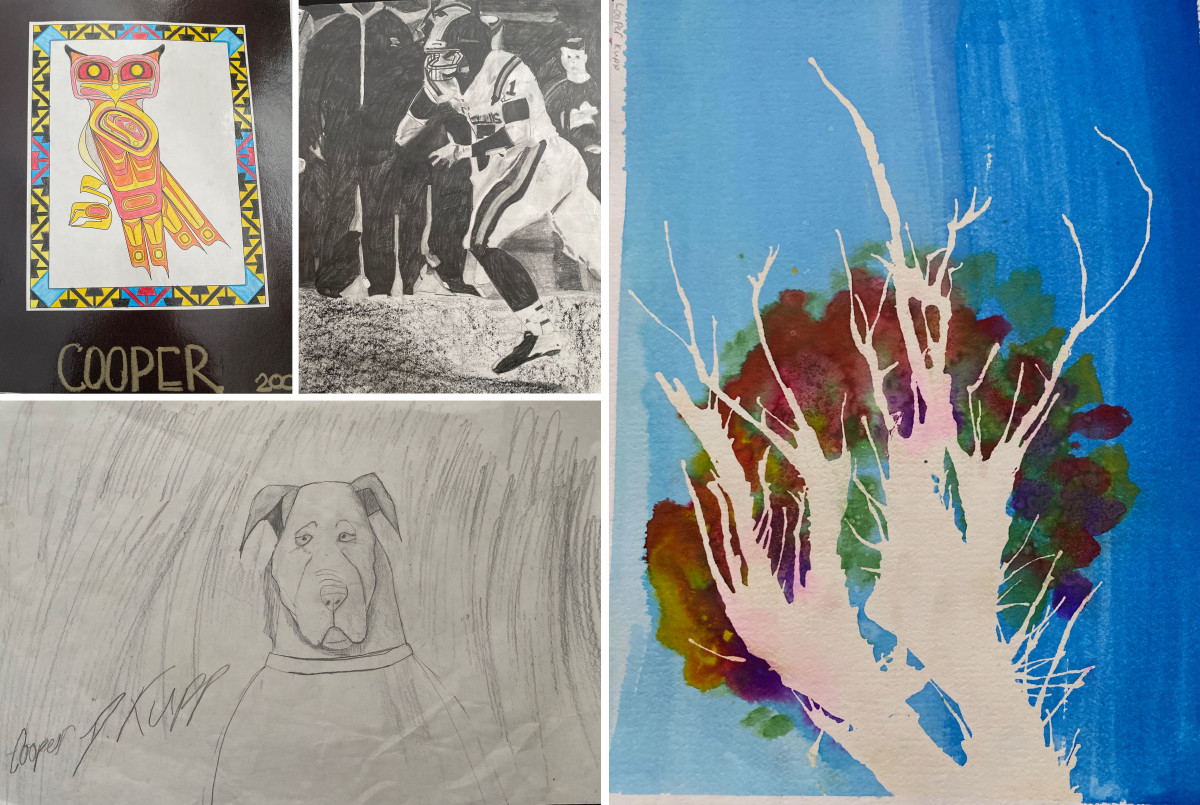
It’s how Kupp kept pace with Rice, Johnson and Irvin all season, his dominance so smooth, so natural, that to Whitworth he played “like he was smoking a cigarette.” It’s why Snead answered a phone call by shouting, “I have Cooper Kupp fatigue!” It’s why, when Baugus visited Kupp during the Rams’ bye week, he spied the uncontrolled manifolds diagram in Kupp’s room, the sheet wrinkled from so many reviews. It’s why Goff and Whitworth both argue that Kupp’s season ranks atop all elite receiver seasons in NFL history, for his influence beyond the staggering statistics, in quantifiable ways and unquantifiable ones. It’s why the Buccaneers are likely to bracket and double-team Kupp on Sunday in the same way the Cardinals did in the Rams’ playoff opener Monday night.
It’s not Kupp’s process that mattered in 2021. It’s what that process yielded.
Cooper Kupp is a football artist. And his artistry is best explained not by science, but by how he applied a systematic approach to mastering one specific play.
“The option route,” Irvin says.
This route, Irvin argues, encapsulates one receiver and his “something special” season. Kupp runs options from all receiver positions, collecting data from the variables he studies, to change directions, stop short or go long. His central nervous system can select preferred movement options, based on the data he inputs, allowing for adjustments after the ball is snapped. That’s the science. When Irvin watches these natural, split-second alterations, he’s transfixed and a tad envious, because he sees a receiver who knows not just how to get open, but when to separate. Irvin loves when Kupp walks off the line on one play, then flies forward the next. That’s the art.
“Cooper has mastered this. He’s a baaaaaaddddd boy,” Irvin says. “It starts with understanding, but it’s a lot more than understanding. That’s why what he does is totally different than anyone else.”
That anecdote is relayed to Craig in Yakima. Snow blankets the high school football field where his son began to dream of the Hall of Fame. Craig points, shifts and mimics, memories returning. He pauses, as if he’s unsure whether he should voice the notion in his head. So much distance—and so many experiments—stand between those years and this season, and yet, one person who always knew the answer to, “Who the heck is Cooper Kupp?” did not laugh when his teenage son scribbled “Pro Football Hall of Fame” onto a vision board. “I mean … I … I thought …,” Craig stammers.
Screw it. “I really did think it was not out of the realm of possibility,” he says.
That’s the thing about a masterpiece. It’s just brush strokes, just scribbles, just an idea. Until, one day, it becomes a defining work of art.
• Arts and Crafts, Belichick-Style
• Mac Jones: Reassessing the 2021 Draft’s Most Polarizing Player
• A Quarterback Evolution and a Coaching Revolution
• The German Import Helping Define the Post-Tom Brady Patriots
